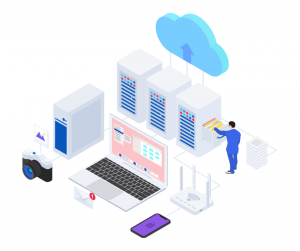Published on 12 September 2022
Cloud and cloud migration can seem like complicated topics. It can be tricky to know where to begin or how it could be the right choice for your company. We’ve put together this blog to answer your questions about the cloud and the best steps to take when migrating to the cloud.
The cloud allows you to access your files and data via the internet. Making it easier to access your files from anywhere, at any time. The cloud is a global network of servers with computing power and data storage that connects you to your files and software. Public clouds, like Microsoft Azure, will have multiple servers all over the world. They will store several copies of your data in multiple locations, ensuring your data is always available.
Cloud migration is when you move your company’s data, applications, and other digital aspects from your on-site servers to the cloud. Similar to moving house, cloud migration needs careful planning and analysis, but the benefits are well worth it. In the long-term, you can save on costs, improve flexibility and collaboration for staff, and overall become more efficient. Without careful planning, your cloud migration could end up costing you more.
Continuing to use on-site servers to store your data and run applications, leaves your company at a disadvantage. Out-of-date hardware and software can become unreliable and slow, leading to slower productivity and unwanted downtime. Not to mention if there is physical damage to your servers, for example, water damage. Downtime like this could be devastating to your company, especially if it takes a long time to get the servers up and running again. There may be significant data loss as a result of server damage, further disrupting the operations of your company.

Cloud migration comes with a host of benefits that suit any company large or small:
Cloud providers invest heavily in both their physical and cyber security. It is an integral part of their business model. They need to provide the best and most sophisticated security, otherwise, if there was a breach, they could jeopardise thousands of different companies’ data. A cloud provider can provide enterprise-grade security at a price that is achievable to small companies.
The cloud has allowed small companies to achieve similar disaster recovery solutions to that of larger companies without incurring the steep price. For example, if your office must be shut down because of fire damage, you won’t experience any downtime as your staff will be able to access all their data whilst working from home.
It is easy and quick to scale up and down with cloud solutions. The agility that companies achieve when migrating to the cloud allows them to quickly adapt to changing environments and grow without disrupting workflow.
The cloud allows your staff to access their data from anywhere at any time provided they have an internet connection. This gives you a huge hiring advantage, you will be able to secure the right person for the job without geographical limitations.
One of the huge benefits of migrating to the cloud is the expenditure your company will save. You will no longer need to invest in on-site servers, this includes electricity and maintenance of the servers. Your cloud provider will manage, maintain, and update their servers, which you use to access your data.
Going a step further you could save on devices. By opting for a cloud environment, your employees can access your company’s data from any device. Meaning you can implement a Bring Your Own Device (BYOD) policy and reduce spending on work devices.

The steps a company will take when migrating to the cloud can vary depending on its objectives. However, there are four steps that most companies follow:
Firstly, you need to think about why you, as a company, want to migrate to the cloud. This could be to improve your staff’s user experience, to be more adaptable to the evolving work environment, or to upgrade to more sophisticated security. Once you know why you want to migrate to the cloud you need to consider how you will migrate. For information on the different ways to migrate to the cloud, check out our eBook.
Next, you need to assess your environment and infrastructure. Think about what data you use daily that you need to have access to in order to remain operational. Your non-critical data can be slowly migrated over time. It is a good idea to talk to your cloud migration provider to determine the best plan of action when migrating your data.
Keep in mind the costs involved in migrating your data to the cloud, and the cost of maintaining it. Cloud migration will save you costs in the long run, but without proper evaluation, understanding and planning, you could end up spending more than you expected on the initial migration. The right cloud service provider will be able to build a migration strategy that aligns with your budget and objectives.
The main challenge when deploying your cloud migration strategy is avoiding downtime and keeping disruption to a minimum. If, during the process, your staff struggle to access the files and data that are critical for your business to remain operational it could result in loss of business.
Once your files and data have been successfully migrated to the cloud you need to consider data loss prevention policies and secure device management. Now that your employees can easily access their files and data, you need to ensure that proper protection is in place to keep your company data protected.

Cloud migration, unfortunately, is not simple. It requires planning, strategy, and finding the right solution for you. With the right provider, this process will be smooth, with minimal disruption to operations. It can be a daunting process when considering migrating to the cloud, it’s easy to just keep putting it off, but with the fast-evolving business environment you could be in danger of losing your competitive edge. Fortunately, as an IT and Cloud service provider, we understand the struggles and have created a handy Cloud Migration Checklist guide to cover everything you need to know when it comes to cloud migration. And don’t worry we’ve made sure it’s easy to understand, whatever your knowledge of IT and technology is.
If you are ready to talk about cloud migration today, book a meeting with one of our experts below.

© 2025 Bluebell IT Solutions - All rights reserved
SEO and Website Design by Loop Digital